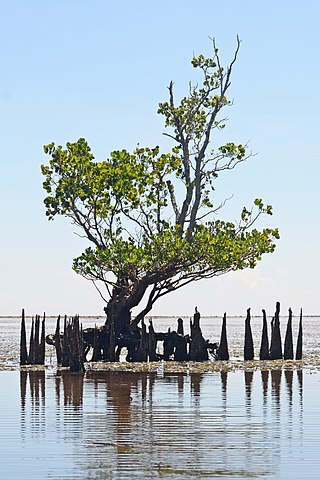
A mangrove is a shrub or tree that grows mainly in coastal saline or brackish water. Mangroves grow in an equatorial climate, typically along coastlines and tidal rivers. They have special adaptations to take in extra oxygen and to remove salt, which allow them to tolerate conditions that would kill most plants. The term is also used for tropical coastal vegetation consisting of such species. Mangroves are taxonomically diverse, as a result of convergent evolution in several plant families. They occur worldwide in the tropics and subtropics and even some temperate coastal areas, mainly between latitudes 30° N and 30° S, with the greatest mangrove area within 5° of the equator. Mangrove plant families first appeared during the Late Cretaceous to Paleocene epochs, and became widely distributed in part due to the movement of tectonic plates. The oldest known fossils of mangrove palm date to 75 million years ago.

The littoral zone, also called litoral or nearshore, is the part of a sea, lake, or river that is close to the shore. In coastal ecology, the littoral zone includes the intertidal zone extending from the high water mark, to coastal areas that are permanently submerged — known as the foreshore — and the terms are often used interchangeably. However, the geographical meaning of littoral zone extends well beyond the intertidal zone to include all neritic waters within the bounds of continental shelves.

A tide pool or rock pool is a shallow pool of seawater that forms on the rocky intertidal shore. These pools typically range from a few inches to a few feet deep and a few feet across. Many of these pools exist as separate bodies of water only at low tide, as seawater gets trapped when the tide recedes. Tides are caused by the gravitational pull of the sun and moon. A tidal cycle is usually about 25 hours and consists of one or two high tides and two low tides.

Primary succession is the beginning step of ecological succession after an extreme disturbance, which usually occurs in an environment devoid of vegetation and other organisms. These environments are typically lacking in soil, as disturbances like lava flow or retreating glaciers scour the environment clear of nutrients.

The aggregating anemone, or clonal anemone, is the most abundant species of sea anemone found on rocky, tide swept shores along the Pacific coast of North America. This cnidarian hosts endosymbiotic algae called zooxanthellae that contribute substantially to primary productivity in the intertidal zone. The aggregating anemone has become a model organism for the study of temperate cnidarian-algal symbioses.
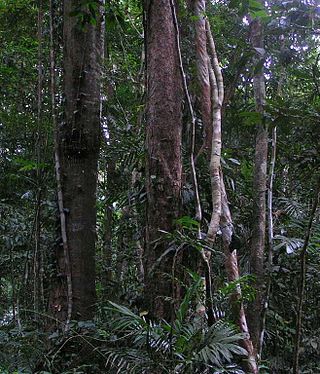
Forest ecology is the scientific study of the interrelated patterns, processes, flora, fauna and ecosystems in forests. The management of forests is known as forestry, silviculture, and forest management. A forest ecosystem is a natural woodland unit consisting of all plants, animals, and micro-organisms in that area functioning together with all of the non-living physical (abiotic) factors of the environment.

In ecology, a disturbance is a temporary change in environmental conditions that causes a pronounced change in an ecosystem. Disturbances often act quickly and with great effect, to alter the physical structure or arrangement of biotic and abiotic elements. A disturbance can also occur over a long period of time and can impact the biodiversity within an ecosystem.
Ecological facilitation or probiosis describes species interactions that benefit at least one of the participants and cause harm to neither. Facilitations can be categorized as mutualisms, in which both species benefit, or commensalisms, in which one species benefits and the other is unaffected. This article addresses both the mechanisms of facilitation and the increasing information available concerning the impacts of facilitation on community ecology.

Intertidal ecology is the study of intertidal ecosystems, where organisms live between the low and high tide lines. At low tide, the intertidal is exposed whereas at high tide, the intertidal is underwater. Intertidal ecologists therefore study the interactions between intertidal organisms and their environment, as well as between different species of intertidal organisms within a particular intertidal community. The most important environmental and species interactions may vary based on the type of intertidal community being studied, the broadest of classifications being based on substrates—rocky shore and soft bottom communities.

A treefall gap is a distinguishable hole in the canopy of a forest with vertical sides extending through all levels down to an average height of 2 m (6.6 ft) above ground. These holes occur as result of a fallen tree or large limb. The ecologist who developed this definition used two meters because he believed that "a regrowth height of 2 m was sufficient" for a gap to be considered closed, but not all scientists agree. For example, Runkle believed that regrowth should be 10–20 m (33–66 ft) above the ground. Alternatively, a treefall gap is "the smallest gap [that must] be readily distinguishable amid the complexity of forest structure."

Rhizophora mangle, the red mangrove, is distributed in estuarine ecosystems throughout the tropics. Its viviparous "seeds", in actuality called propagules, become fully mature plants before dropping off the parent tree. These are dispersed by water until eventually embedding in the shallows.
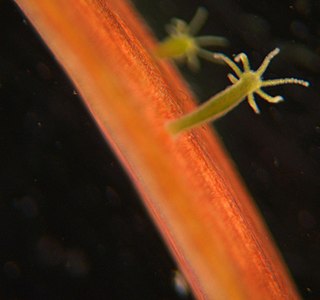
Sessility is the biological property of an organism describing its lack of a means of self-locomotion. Sessile organisms for which natural motility is absent are normally immobile. This is distinct from the botanical concept of sessility, which refers to an organism or biological structure attached directly by its base without a stalk.
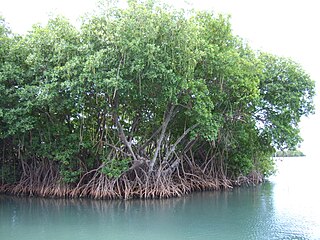
Mangrove ecosystems represent natural capital capable of producing a wide range of goods and services for coastal environments and communities and society as a whole. Some of these outputs, such as timber, are freely exchanged in formal markets. Value is determined in these markets through exchange and quantified in terms of price. Mangroves are important for aquatic life and home for many species of fish.

Ulva linza is a green alga in the family Ulvaceae that can be found in British Isles.

Marine fungi are species of fungi that live in marine or estuarine environments. They are not a taxonomic group, but share a common habitat. Obligate marine fungi grow exclusively in the marine habitat while wholly or sporadically submerged in sea water. Facultative marine fungi normally occupy terrestrial or freshwater habitats, but are capable of living or even sporulating in a marine habitat. About 444 species of marine fungi have been described, including seven genera and ten species of basidiomycetes, and 177 genera and 360 species of ascomycetes. The remainder of the marine fungi are chytrids and mitosporic or asexual fungi. Many species of marine fungi are known only from spores and it is likely a large number of species have yet to be discovered. In fact, it is thought that less than 1% of all marine fungal species have been described, due to difficulty in targeting marine fungal DNA and difficulties that arise in attempting to grow cultures of marine fungi. It is impracticable to culture many of these fungi, but their nature can be investigated by examining seawater samples and undertaking rDNA analysis of the fungal material found.

Gap dynamics refers to the pattern of plant growth that occurs following the creation of a forest gap, a local area of natural disturbance that results in an opening in the canopy of a forest. Gap dynamics are a typical characteristic of both temperate and tropical forests and have a wide variety of causes and effects on forest life.
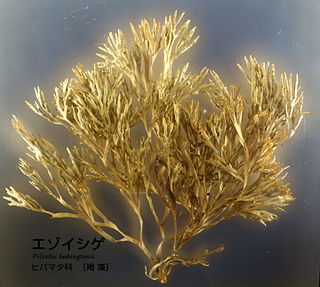
Silvetia is a genus of brown algae, commonly known as rockweed, found in the intertidal zone of rocky seashores of the Pacific Ocean. These were originally classified as members of the genus Pelvetia. In 1999, Silvetia sp. was created as a separate species from Pelvetia canaliculata due to differences of oogonium structure and of nucleic acid sequences of the rDNA. It was renamed in honor of Paul Silva, Curator of Algae at the Herbarium of the University of California, Berkeley. There are three species and one subspecies.

In ecology, a light gap is a break in forest canopy or similar barrier that allows young plants to grow where they would be otherwise inhibited by the lack of light reaching the seedbed. Light gaps form predominantly when a tree falls, and thus produces an opening in the forest canopy. Light gaps are important for maintaining diversity in species-rich ecosystems.
A habitat cascade is a common type of a facilitation cascade. where “indirect positive effects on focal organisms are mediated by successive formation or modification of biogenic habitat”.
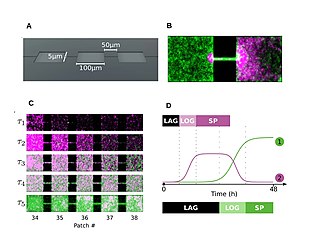
In ecology, the competition–colonization trade-off is a stabilizing mechanism that has been proposed to explain species diversity in some biological systems, especially those that are not in equilibrium. In which case some species are particularly good at colonizing and others have well-established survival abilities. The concept of the competition-colonization trade-off was originally proposed by Levins and Culver, the model indicated that two species could coexist if one had impeccable competition skill and the other was excellent at colonizing. The model indicates that there is typically a trade-off, in which a species is typically better at either competing or colonizing. A later model, labelled The Lottery Model was also proposed, in which interspecific competition is accounted for within the population.















